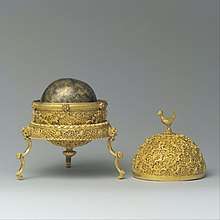Goa stone
A Goa stone or Lapis de Goa was a man-made bezoar that was considered to have medicinal and talismanic properties and were manufactured from Goa, India and exported to apothecaries in Europe from the mid-16th to 18th century.[1] Goa stones were manufactured by Jesuits in the late seventeenth century in Goa because naturally occurring bezoars were scarce.[2] Their inventor was the Florentine lay brother Gaspar Antonio, and a Jesuit monopoly was confirmed by the Portuguese on March 6, 1691.[3] They were created by combining organic and inorganic materials including hair, fossil shark teeth, shells, tusks, resin, and crushed gems, then shaping the materials into a ball and covering it with gilt. Like bezoar stones, Goa stones were thought to prevent disease and cure poisoning.[4] They could be administered by shaving off small pieces into a drinkable beverage like water, tea, or wine.[5]

After the death of Gaspar Antonio the recipe went to Father Jorge Ungarate. The Jesuits were forced to leave Goa in 1759 and these stones were then produced by Capuchin friars at the Convento da Madre de Deus until 1835. The secret recipe was then passed on to Manuel do Carmo Pacheco who produced these stones until his death in 1868.[6] The stones made their way to England as well and an early mention is made in 1686 by Gideon Harvey who was sceptical of the curative value noting that they were confected from a "jumble of Indian Ingredients" by "knavish Makers and Traffickers.'"[7]
Goa stones were kept in ornate, solid gold or gilded cases that were believed to enhance the medicinal properties of the stones.[8] The cases usually featured a busy network of filigree, occasionally adorned with ornaments of animals, including monkeys, unicorns, dogs, and parrots.[9]
References
- "Goa Stone with Gold Case". The Metropolitan Museum of Art. The Metropolitan Museum of Art. Retrieved 19 November 2017.
- Bailly, Muriel. "Foolish Remedies: Goa Stone". Wellcome Collection. Wellcome Collection. Archived from the original on 1 December 2017. Retrieved 19 November 2017.
- Fonseca, José Nicolau da (1878). An Historical and Archæological Sketch of the City of Goa: Preceded by a Short Statistical Account of the Territory of Goa. Thacker & Company, limited. pp. 317.
- "Bezoar Stone with Case and Stand". The Metropolitan Museum of Art. The Metropolitan Museum of Art. Retrieved 19 November 2017.
- Duffin, Christopher J. (2017). "Fossil Sharks' Teeth as Alexipharmics". Toxicology in the Middle Ages and Renaissance. pp. 125–133. doi:10.1016/B978-0-12-809554-6.00012-3. ISBN 9780128095546.
- Duffin, Christopher (2010). "Lapis de Goa: the 'cordial stone'". Pharmaceutical Historian. 40 (2): 22–30. PMID 20695233.
- Duffin, Christopher (2010). "Lapis de Goa: the 'Cordial Stone'-part two". Pharmaceutical Historian. 40 (3): 42–46.
- Grundhauser, Eric (2016-07-05). "The Man-Made Gut Stones Once Used to Thwart Assassination Attempts". Atlas Obscura. Atlas Obscura. Retrieved 19 November 2017.
- Ekhtiar, Maryam. "Paradox". YouTube. The Metropolitan Museum of Art. Retrieved 19 November 2017.